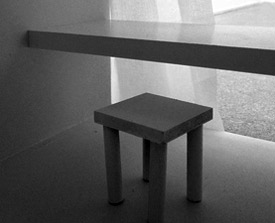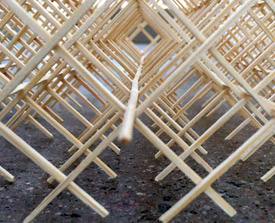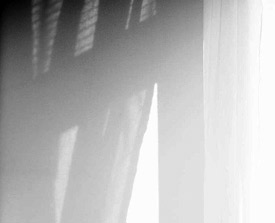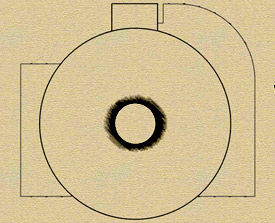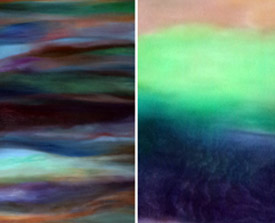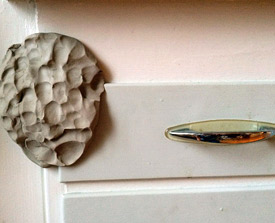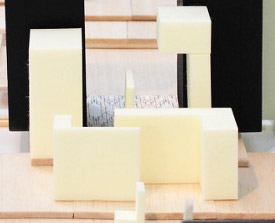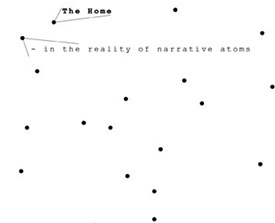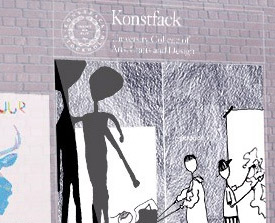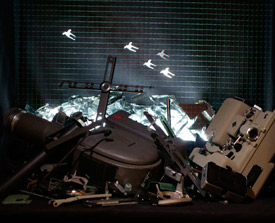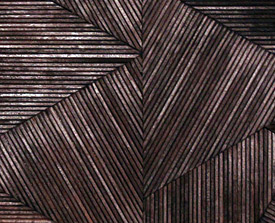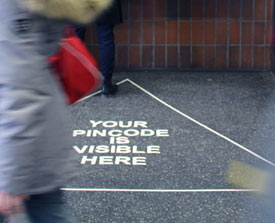Konstfack Degree Exhibition 2015 / Vårutställning 2015
Where is an Interior?
Can the densification through the accumulation of objects constitute an interior, independent of boundaries? Or is the interior dependent on the boundaries and structures that envelope them? Walter Benjamin, in his Das Passagen-Werk or Arcades Project, pointed out that the 19th century development of material and structural use of cast iron and glass, for arcades and winter gardens, were tightly integrated with an understanding of the experience of the interior. These curved hall structures were primarily over covered spaces. Passages without an outside. But we have also seen, that the interior (as well as the façade), is often quickly considered obsolete, is scraped out, replaced or exchangeable for something else. How does the interior alter the balance between permanence and instability?
The collector, or the more obsessive hoarder, assembles interiors through the act of gathering, arraying and relocating large quantities of stuff, regardless of what surrounds them. In her text “Architecture in Extremis,” Sylvia Lavin points out that hoarding is not about use or representation, but has a focus on the materiality of things. Through the process of densification, hoarding frees the interior from typical conventions of use. Placing and the displacement of things, makes the interior a live archive, continuously in production.
The (in)stability of interiors provides opportunities to use interiors and their immediate past (of interiors) as active archives for redefining where and what is an interior, to redefine the field and profession of interior architecture and furniture design, and to challenge the cultural project of architecture.
This year’s master’s exhibition from Interior Architecture and Furniture Design’s InSpace programme shows a diversity of approaches to the field and the profession. We will be able to ask:
How the archival production of narratives of the life of a home, actively rewrites the history of the recent past of an interior. How an obsession for order can create a need for the breaking of rules. How a care and passion for obsolete mechanical objects, resourcefully challenges the perception and experience of our physical environments. How the control or out of control of local climate change produces interiors. How an intense focus on materiality, texture and colour of interior surfaces, detached from the support of buildings, reorganizes the experience of interiors and produce a tension between envelope and interior. How the structure of sign and language both produces fear and comfort in public interiors. How scale and size form the interior. How analogue documentation and computational copying of details and domestic things challenge the use, the figure and craft of stucco. How shortage of housing in Stockholm asks for a reconsideration of living conditions. How the knowledge and skill of others, craftsmanship, inform the creative practice of the interior architect. How drawing can communicate public transformation.
Ulrika Karlsson, Professor of Interior Architecture and Furniture Design
*Sylvia Lavin, Architecture in Extremis, Log 22, Anyone Corporation (2011) page 51-61.
Var är en interiör?
Kan en interiör utgöras av en ackumulering av föremål, en förtätning, oberoende av avgränsningar? Eller är interiörer beroende av gränser och strukturer som omsluter dem? Walter Benjamin påpekade, i hans Das Passagen-Werk eller Paris, 1800-talets huvudstad: Passagearbetet att 1800-talets utveckling av den strukturella användningen av gjutjärn och glas, för arkader och vinterträdgårdar, var tätt integrerat med en förståelse för upplevelsen av interiören. Dessa utgjordes av böjda hallstrukturer, som framförallt övertäckte en rymd. Passager utan en utsida. Men vi har också sett att inredningar (liksom fasader), ofta snabbt anses föråldrade, skrapas bort, ersätts eller byts ut mot något annat. Hur förändrar interiören balansen mellan varaktighet och instabilitet?
Samlaren eller den mer besatta hamstraren, sätter samman interiörer genom att ansamla, ställa upp och flytta stora mängder av saker, oavsett vad som omger dem. I sin text Architecture in Extremis, påpekar Sylvia Lavin att i hamstring som aktivitet, finns ett fokus på det materiella i saker och ting, snarare än på användning eller representation. Genom processen av förtätning, frigör samlaren interiören från typiska konventioner för användning. Placering och förskjutningen av saker, gör interiören till ett levande arkiv, kontinuerligt i produktionen.*
(In)stabiliteten hos interiörer, gör det möjligt att använda dem och deras förflutna som aktiva arkiv för att omdefiniera var och vad en interiör är, omdefiniera fältet och yrket inredningsarkitektur och möbeldesign, och att utmana arkitekturens kulturella projekt.
Årets masterutställning från Inredningsarkitektur och möbeldesigns masterprogram InSpace visar en mångfald av metoder och förhållningssätt till fältet och yrket. Vi kommer att kunna fråga:
Hur den arkiviska produktionen av berättelser om livet i ett hem aktivt skriver om en interiörs närhistoria. Hur ett fullständigt fokus för ordning kan skapa ett behov av att bryta regler. Hur en omsorg och passion för obsoleta föråldrade tekniska föremål resursmässigt utmanar vår uppfattning och erfarenhet av vår fysiska miljö. Hur kontrollen eller förlust av kontroll av lokala klimatförändringar producerar interiörer. Hur en intensiv fokusering på materialitet, textur och färg av interiörers invändiga ytor, fristående från strukturer hos byggnader, omorganiserar upplevelsen och producerar en spänning mellan hölje och interiör. Hur strukturen hos tecken och språk både producerar rädsla och komfort i offentliga miljöer. Hur skala och storlek formar interiörer. Hur analog dokumentation och digitalt styrda tekniker för kopiering av detaljer och vardagsting utmanar användningen, figuren och hantverket av stuckatur. Hur brist på bostäder i Stockholm ber om en omprövning av levnadsförhållanden. Hur kunskapen och hantverksskickligheten hos andra informerar inredningsarkitektens kreativa processer. Hur ritningen kan kommunicera offentlig förändring.
Ulrika Karlsson, professor i Inredningsarkitektur och Möbeldesign
*Sylvia Lavin, Architecture in Extremis, Log 22, Anyone Corporation (2011) sid 51-61.
